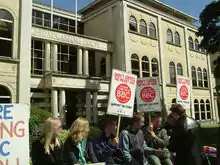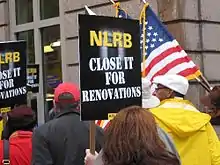Picketing
Picketing is a form of protest in which people (called pickets or picketers)[1] congregate outside a place of work or location where an event is taking place. Often, this is done in an attempt to dissuade others from going in ("crossing the picket line"), but it can also be done to draw public attention to a cause. Picketers normally endeavor to be non-violent. It can have a number of aims, but is generally to put pressure on the party targeted to meet particular demands or cease operations. This pressure is achieved by harming the business through loss of customers and negative publicity, or by discouraging or preventing workers or customers from entering the site and thereby preventing the business from operating normally.

Picketing is a common tactic used by trade unions during strikes, who will try to prevent dissident members of the union, members of other unions and non-unionised workers from working. Those who cross the picket line and work despite the strike are known pejoratively as scabs.
Types of picket
Informational picketing is the legal name given to the type of picketing described above. Informational picketing, as described by Merriam-Webster's Dictionary of Law, entails picketing by a group, typically a labour or trade union, which inform the public about a matter of concern important to the union.[2] It is a popular picketing technique for nurses to use outside of healthcare facilities. For example, on April 5, 2006 nurses of the UMass Memorial Medical Center (UMMHC) participated in two separate informational picketing events to protect the quality of their nursing program.[3] Informational picketing was used to gain public support and promote further bargaining with management.[3]
A mass picket is an attempt to bring as many people as possible to a picket line to demonstrate support for the cause. It is primarily used when only one workplace is being picketed or for a symbolically or practically important workplace. Due to the numbers involved, a mass picket may turn into a potentially unlawful blockade.
Secondary picketing is the picketing of locations that are directly connected to the issue of protest. That would include component suppliers on which the picketed business relies, retail stores that sell products by the company against which is being picketed, sister companies of the company involved in the dispute and the private homes of the company's management. In many jurisdictions, secondary pickets do not have the same civil law protection as primary pickets.
An example of this is the Battle of Saltley Gate in 1972 in Britain, when striking miners picketed a coke works in Birmingham and were later joined by thousands of workers from other industries in the local area. The tactic of secondary picketing was outlawed in the United Kingdom by the Conservative Party government of Margaret Thatcher in the mid-1980s, but the Labour opposition led by Neil Kinnock was pushing for it to be legalised before the 1987 general election. However, such plans had been dropped by the time Labour returned to power under Tony Blair in 1997.[4]
Another tactic is to organise highly mobile pickets, who can turn up at any of a company's locations on short notice. These flying pickets are particularly effective against multi-facility businesses that could otherwise pursue legal prior restraint and shift operations among facilities if the location of the picket were known with certainty ahead of time. The first recorded use of flying pickets was during the 1969 miners' strike in Britain.[5]
Picketing is also used by pressure groups across the political spectrum. In particular, by religious groups such as the Westboro Baptist Church that picket a variety of stores or events they consider to be sinful.
Disruptive picketing
Disruptive picketing is where pickets illegally use force, or the threat of force, or physical obstruction, to injure or intimidate or otherwise interfere with either staff, service users, or customers.[6] For example, during the UK miners' strike (1984-1985), strikebreakers were pelted by pickets with stones, paint and brake fluid.[7]
Legality

Picketing, as long as it does not cause obstruction to a highway or intimidation, is legal in many countries and in line with freedom of assembly laws, but many countries have restrictions on the use of picketing.
Legally defined, recognitional picketing is a method of picketing that applies economic pressure to an employer with the specific goal to force the employer to recognise the issues facing employees and address them by bargaining with a union.[8] In the US, this type of picketing, under Section 8(b) (7) (A) of the Labor Act, is typically illegal if representation is not relevant or is unquestionable.[9]
In the UK mass picketing was made illegal under the Trade Disputes and Trade Unions Act 1927 after the 1926 General Strike. The Trade Union and Labour Relations (Consolidation) Act 1992 gives protection, under civil law, for pickets who are acting in connection with an industrial dispute at or near their workplace who are using their picketing peacefully to obtain or communicate information or persuading any person to work or abstain from working. However, many employers have recently taken to gaining injunctions to limit the effect of picketing outside their work place. The granting of injunctions tends to be based on the accusation of intimidation or, in general, on non-peaceful behaviour and the claim that numbers of the picketers are not from the affected workplace.[10]
In the United Kingdom, picketing was banned by a Liberal government in the Criminal Law Amendment Act 1871 but then decriminalised by a Conservative government with the Conspiracy and Protection of Property Act 1875.[11]
In the US, any strike activity was hard to organise in the early 1900s, but picketing became more common after the Norris-LaGuardia Act of 1932, which limited the ability of employers to gain injunctions to stop strikes, and further legislation to support the right to organise for the unions. Mass picketing and secondary picketing was however outlawed by the 1947 Taft-Hartley Act.[12] Some kinds of pickets are constitutionally protected.[13]
Viewing laws against stalking as potentially inconsistent with labour rights of picketing, the first anti-stalking law of the industrial world, made by California's lawmakers, inserted provisions that disapply the law from "normal labor picketing", which has survived subsequent amendments.[14]
See also
- BCGEU v. British Columbia
- Bed-In, peace campaigns by John Lennon and Yoko Ono in 1969
- Dharna, fast undertaken at the door of an offender
- Die-in
- Human Be-In
- Lock-on
- Occupation (protest)
- Occupy movement
- Raasta roko
- Sitdown strike
- Teach-in
- Work-in
References
- "Picketer | Define Picketer at Dictionary.com". Dictionary.reference.com. Retrieved 2010-09-01.
- "informational picketing - Reference.com".
- Twarog,J: "Informational pickets, rallies, vigils and leafleting at health care facilities" Massachusetts Nurse; Apr2006, Vol. 77 Issue 3, p9-9, 2/3p
- "Posters From The Conservative Party Archive".
- Beckett, Andy (2009). When the Lights Went Out: Britain in the Seventies. London: Faber & Faber. p. 70. ISBN 9780571252268.
- Leedom v. Kyne and the Implementation of a National Labor Policy, James F. Wyatt III, Duke Law Journal, Vol. 1981, No. 5 (Nov., 1981), pp. 853–877
- Strike: 358 Days that Shook the Nation. London: Sunday Times. 1985. p. 264. ISBN 0-340-38445-X.
- 52 Geo. L. J. 248 (1963-1964)Federal Regulation of Recognition Picketing ; Shawe, Earle K.
- ""Stale" Contract No Bar to Recognitional Picketing". Labor Law Journal. 17 (6): 384 1/2p. June 1066.
- "Picketing, The Liberty guide to human rights". Liberty. 11 January 2005. Archived from the original on 25 July 2006. Retrieved 9 July 2006.
- "Timeline:1850–1880". TUC history online, Professor Mary Davis, Centre for Trade Union Studies, London Metropolitan University.
- "PICKETING". The Columbia Electronic Encyclopedia. Columbia University Press. Archived from the original on 2007-03-11.
- Thornhill v. Alabama and other cases cited at Free speech zone#Notable incidents and court proceedings
- Penal Code s. 646.1
Further reading
External links
| Look up picketing in Wiktionary, the free dictionary. |
| Wikimedia Commons has media related to Picketing. |
- . Encyclopædia Britannica (11th ed.). 1911.
